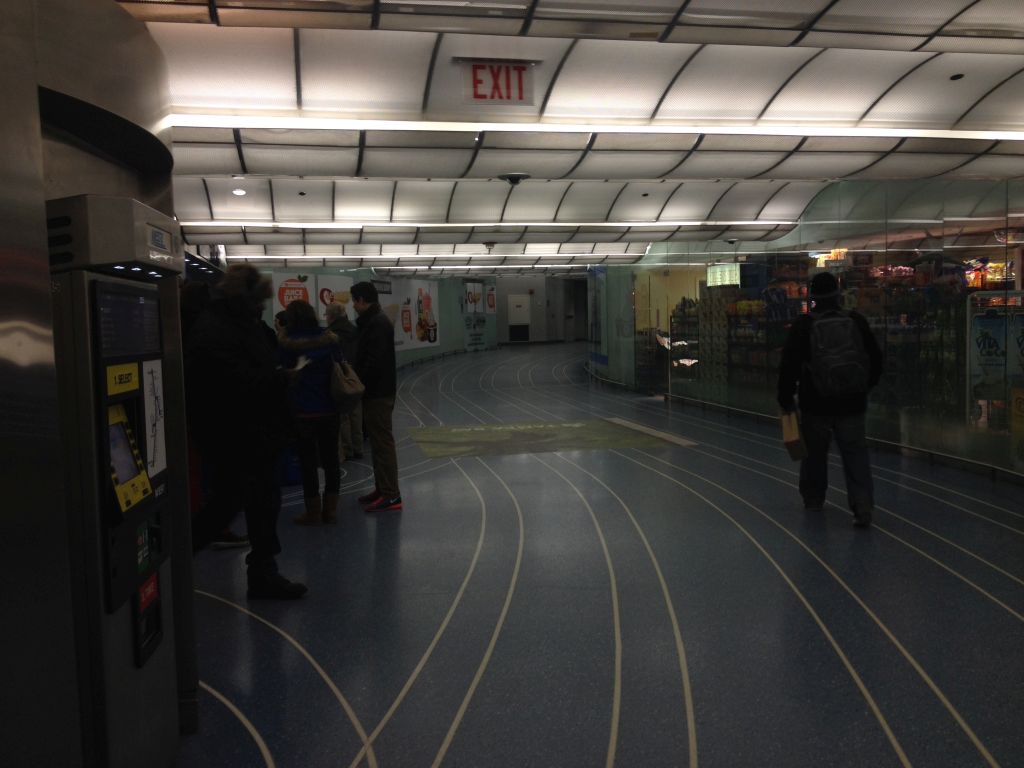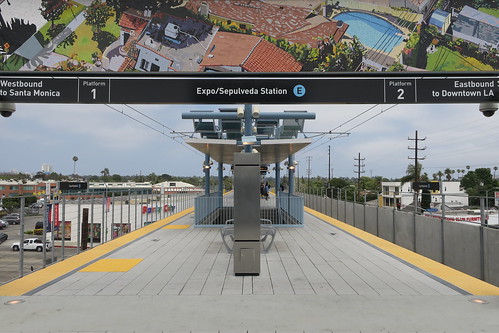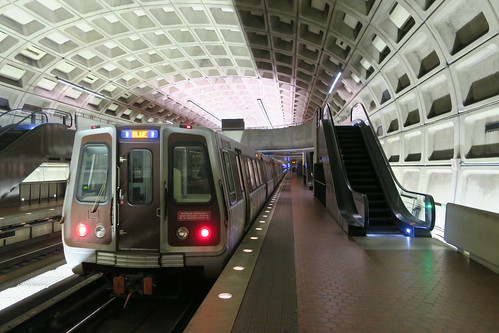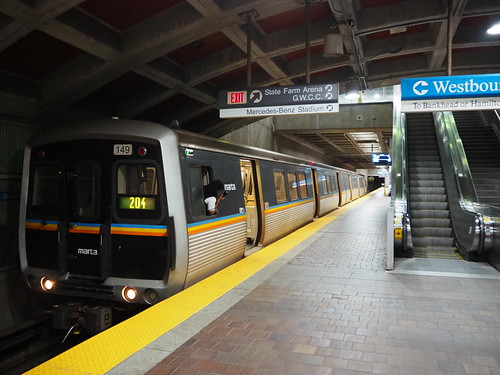I first got my feet wet with regards to photography in about eleventh grade. My first time going out by myself with a camera was on the Los Angeles Metro. I was meeting some family at LACMA while coming from Beverly Hills, so I arranged that I would get dropped off at Culver City, take the Expo Line (now alternately known as the E line) to 7th Street/Metro Center, then transfer to the Purple Line (now also known as the D line), take that out to Wilshire/Western, then meet everyone else there, and we’d drive the rest of way to LACMA, at Wilshire/Fairfax (which will be on the line in a few years, but definitely not in 2013).
Along the trip, I just took pictures of basically anything and everything, not really bothering to pay attention to my subject matter or the quality of the photos. I knew nothing about photography other than you point the camera at something and hit the button. I didn’t even have a camera of my own, I borrowed someone else’s. Here is a sampling of a few photos I took:








That was my first foray into photography. Obviously, those weren’t exactly the world’s best photos, but that’s what got me started.
Cleveland and Chicago, Round 1
Later on, in February 2015, I toured colleges in the Midwestern United States, specifically Carnegie Mellon, Case Western Reserve (which I ended up attending), and Northwestern. This was my second opportunity to try a bit of railroad photography. In Cleveland, I wanted to explore a new transit system, so I took the Red Line from Cedar/University to Tower City to grab lunch there. I forgot to ask to borrow a camera for this one, so I got my pictures with a cell phone. I got some pictures along the way there too:


Later on, after my tour of Northwestern, I ran from there to Millennium Station (about 13 miles) for my long run that week, and then then took the South Shore Line back to South Bend (where I was staying). Once I got to Millennium Station, I took some more pictures while waiting for my train:



Travels in 2016
I traveled some along the way (still using borrowed cameras), to places like Boston…
…and New York City…
My own camera
Then, as I graduated high school, I got my own camera, a Canon Powershot G9X, about the size of a deck of cards. I definitely got familiar with that camera over the next few years. Back in Los Angeles in the summer of 2016, I had my first real rodeo with that camera:
Cleveland, Round 2: a whole new city
Then, after that summer was over, I started college at CWRU. I immediately set out to get pictures of all the train station around Cleveland. Here are some of my preliminary efforts:
Speaking of Tower City, I revisited that station. They were performing maintenance on one of the tracks, so they opened a station on one of the non-revenue tracks:
Definitely some progress was made in the meantime. I was able to better choose subject matter and get it in the frame. The quality was also better, with the pictures being clearer and better focused. However, the alignment was still pretty haphazard, with a lot of the pictures not level at all. I also didn’t really appreciate the importance of lighting just yet.
My next big breakthrough was in alignment, when I went out to Lee-Van Aken. I realized I could line up the camera with reference lines in the picture (in this case I used the power poles), and as a result my pictures were actually consistently level.
I also got to apply these skills elsewhere traveling to Charlotte for a day…
…and New York City again…
…and Los Angeles again…
Around this time, I also got interested in taking pictures of buildings in addition to transit systems.
With that, I felt much more confident in my photography skills. I had definitely seen some improvement, my pictures were clearer and more level. Still, I was missing some things.
The start to 2018: Lighting
The next big improvement in my photography was lighting. Before I didn’t really even think about sunny or cloudy, or where the light sources were indoors. As a result, the colors often didn’t look quite like I wanted or the wrong objects were emphasized. With a renewed emphasis on lighting, I continued my work. In the winter of 2017-2018, I went to San Francisco, with my first vacation that had a really high emphasis on photography:
The improvements definitely showed themselves in San Francisco. Having a photography-oriented trip also was a good opportunity to see for myself what worked and what didn’t. With that, I felt much more confident going forwards. I continued my photography along Cleveland and other places I went. I did my first internship at TransEnterix that following summer as well. Since I didn’t want to take any time off work, my travel opportunities were somewhat limited, just going back to Charlotte for a day (this time trying to aim for a sunnier day) and taking an afternoon trip to Raleigh. However, I had a few days between my last day at the internship and when I had to get back to school, so I took advantage of that to take a quick trip to Washington, DC.
After DC, I felt pretty solid in my abilities. I definitely had the alignment thing down, and I was getting a lot better at lighting.
Richmond and Philadelphia
My next big photo adventure was a day trip to Richmond, Virginia in late 2018. I picked a day with perfectly clear skies, and basically spent all day walking around the city with my camera taking pictures of anything and everything that interested me:
With those two pictures, I began to feel that the limiting factor in my pictures was my camera and no longer the user. In particular, for the nighttime shot, I was having trouble getting the focus where I needed (my camera didn’t have any options beyond five meters other than “infinite distance”) as well as the lighting settings. I also was starting to use manual mode, which was really cumbersome on that camera. I took a mental note that a new camera was in order. Still, I continued on with what I had, and later on went to Philadelphia:
I really gained an appreciation for lighting after this trip. I only had one sunny day, the first one (and I got there late in the day, so I was only really able to get that one skyline photo). I also learned that SEPTA, in contrast to many other subway systems, is very well lit. This made photography much easier and let me get higher quality pictures.
Chicago, Round 2
Over spring break that year, I traveled to Chicago. I returned to Millennium Station, and my new photos were definitely an improvement:
I also got many pictures of the L:
I also got some pictures of buildings and stuff…
That ended up being my last major expedition with my Canon. I had a few minor ones later on, including a brief trip back to Charlotte, a quick trip to Downtown Durham, as well as a trip to Greensboro, which turned out to be my last expedition with that camera:
Transition to a new camera, Atlanta, and beyond
Then, I got a new, more powerful camera: an Olympus E-M10. To take it out for a test drive, I took some pictures around Durham:
The camera felt way more powerful than my previous one. It took me a while to get used to all its features and how to use them, but I knew this was a major step forwards. In the middle of the summer, I took a solo trip to Atlanta, and that is still to date my most successful photography expedition:
I definitely was still getting the hang of the whole exposure/ISO/F-stop thing, as evidenced by the lighting in some of these photos. Still, these photos were clearer than anything I had done before, and I felt much more in control. It was also awesome traveling solo for photography, which gave me a ton of practice.
For my final fall break I decided to travel to Pittsburgh with a friend. It was only for a few days, but I still had plenty of opportunities for photography:
I had gotten a better feel for all the settings on my camera this time, so my pictures came out looking more or less how I wanted them.
I also traveled to Los Angeles and San Diego in the winter of 2019-2020, which I have already talked about in another post.
So, since I took up photography, my skills have improved dramatically. It wasn’t a sudden shift, but something that happened over time. I’m moving to Chicago soon, and that will give me a whole new city to explore. I look forward to what I find there, and hope my skills continue to improve. The future holds exciting things, and I can’t wait to see (and photograph) what they are.

















































































































